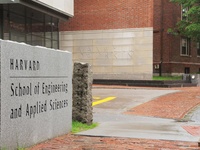But in addition to the potential cutting of SEAS financial backing, some professors express concerns that federal support could dry up—a trend that affects some fields more than others.
Murray says the possibility that federal funding will stagnate presents a “real worry” for SEAS. Funding from NIH will continue to grow, but at a slowing rate, while funding from the National Science Foundation will also increase at a relatively slow pace, she says.
“It’s hard to find sources for resources for graduate research,” says Roger W. Brockett, professor of electrical engineering and computer science. “The federal government decided a few years back it was going to make universities pay more for its graduate students.”
Dumay says that SEAS plans to deal with any potential funding issues by continuing to enhance its allocation of resources while seeking to diversify its funding.
SEAS hopes to supplement any potential loss of federal or school funding with either endorsements from industries or support from foundations, as more institutions increasingly seek to split their research costs with universities, according to Dumay.
“In all areas, we will continue to think about how to use resources,” he says. “Do we shift resources? Do we use different funding sources?”
But a cut in the graduate program could stymie growth in the faculty, as many members join with the expectation of having a certain number of graduate students in their laboratories, according to Venky.
“You cannot run a healthy research enterprise and an undergraduate education without a healthy graduate program,” he says. “If SEAS has to grow its faculty, then the graduate body has to grow.”
“The size of the faculty, the graduate student body, and space are all linked,” he adds.
SEAS IN FAS, IN FUTURE
Facing large-scale expansions in its undergraduate and faculty footprints, SEAS must look to surmount the challenge of continuing its expansion while it recognizes its financial constraints.
The school plans to optimize its budget by accessing overlooked funds, thus regaining a few million dollars and bolstering its existing income stream with new funding from the private and industrial sectors, according to Dumay. These methods would allow for the various plans for expansion.
“We plan to grow without growing apart,” Murray wrote in an e-mailed statement in March.
At the same time, SEAS hopes to find its niche within the University—by working with FAS, for example.
Smith affirms that SEAS’s place is “really embedded” into the larger umbrella of FAS. “It really excels because of the kinds of connections it has more broadly,” he adds.
With a constantly evolving identity, SEAS confronts the challenge of fine-tuning its goals for expansion so that it may ultimately find its place within the larger University.
—Staff writer Gautam S. Kumar can be reached at gkumar@college.harvard.edu.
—Staff writer Evan T.R. Rosenman can be reached at erosenm@fas.harvard.edu.









